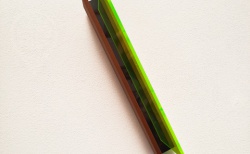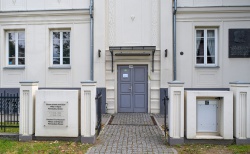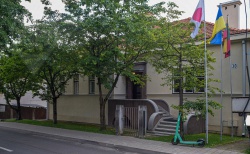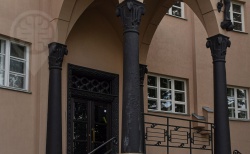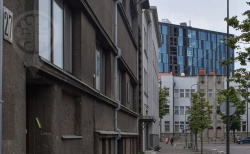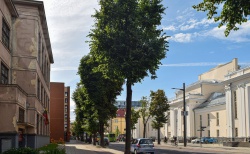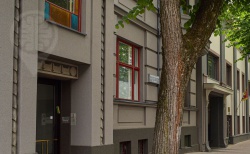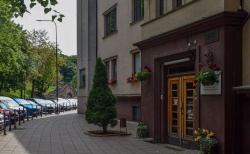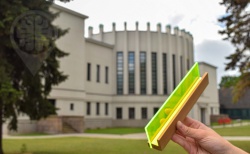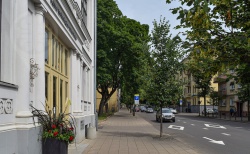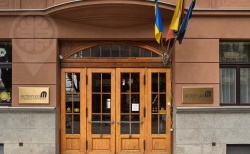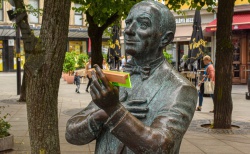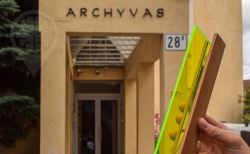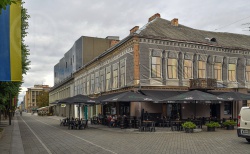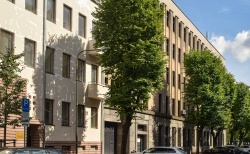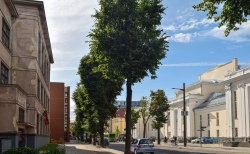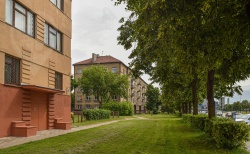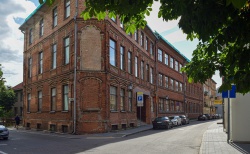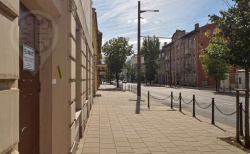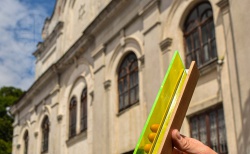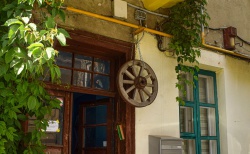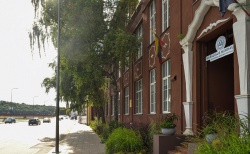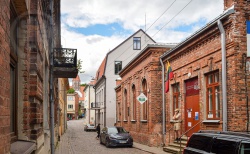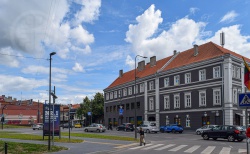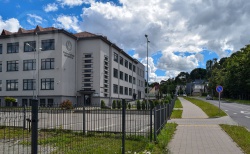About the Route
Welcome! Shalom! Thank you for joining us. Threshold is a sculpture tour inspired by the mezuzah, a small ritual object which Jewish people fix to the doorways of their homes and workplaces. A mezuzah contains a sacred scroll on which is written a Hebrew prayer and marks the human passage between private and public space. For Jews, a mezuzah is a mark of belonging and a visual reminder to uphold good values in life. Before WWII Kaunas was home to almost 40,000 Jews - a quarter of the population - and the mezuzah was a common sight on thousands of doorways. But after the Holocaust, this visible sign of Jewish life vanished without a trace, along with the people. Threshold re-introduces the language of mezuzah onto Kaunas streets.
1 The House of Mikas and Kipras Petrauskas
The singer Kipras Petrauskas and his wife Elena have been declared Righteous Among the Nations for opening the door of their heart and home to Siuze (Danute) Pomerancaite, who was born in the ghetto. The one-and-a-half-year-old daughter of the famous violinist Daniel Pomerantz was brought from the ghetto to this home in a sack of potatoes. For security reasons, she was given a sleeping pill.
2 Chiune Sugihara House
In 1939, the Japanese Consulate was opened in the building, with Consul Chiune Sugihara working there. Jews fleeing the Soviet and Nazi occupation asked him to sign Japanese transit visas allowing them to leave Lithuania, already occupied by the Soviets. He was assisted in this mission by Jan Zwartendijk, Honorary Consul of the Netherlands. Thanks to both diplomats, some 6,000 Jews were saved. Their descendants today number 40,000 people.
3 The House of Moses Posvianskis and Hirsch Klis
This striking apartment block was built in 1928 by two Jewish businessmen, Moses Posvianskis and Hirsch Klis. They were co-owners of the large textile company AB Liteksas. The owners and their families lived in the second-floor flats, while the rest of the flats were rented out, as was customary for the period. The fate of the owners during WWII is unknown.
4 Isaac Levitan Obstetric Clinic
The Kaunas Christian Maternity Home was founded in 1926 by the doctor Isaac Levitan, who established a private midwifery clinic here. The second floor of the building was the apartment of the Levitan family. Levitan was an active Zionist and was twice deported by the Soviet authorities because of his activities.
5 Dr. Elkes' House and Private Hospital
This house was built in 1930 by the well-known Kaunas physician Elchanan Elkes. The first and third floors of the building were rented out, and he set up a private clinic on the second floor and moved in with his family. Elkes treated Kaunas high society, but he also accepted patients who were unable to pay for their treatment. During WWII, he was elected chairman of the Council of Elders of the Kaunas Ghetto and died in 1944 in Dachau concentration camp.
6 Pranas Gudavičius' House
Jurgis Stromas, Director of the Department of Industry and Trade of the Ministry of Finance of Lithuania and Director of the company "Parama", lived in one of the apartments in this house, which belonged to Pranas Gudavičius. He was brutally murdered together with dozens of other Jews during the massacre of the Lietūkis garage in June 1941. The mezuzah is hung on the door of Apartment 5, the apartment that houses the Art Deco Museum.
7 Pranas Mažylis Hospital
The obstetrician-gynecologist Pranas Mažylis, who opened this maternity hospital between the wars, is listed among the Righteous Among the Nations. During WWII, he hid Jews both in his family apartment on the ground floor of the hospital and in the hospital itself.
8 M. K. Čiurlionis National Museum of Art
During WWII, Pranas Baleniūnas, an employee of the Museum, is said to have organized a hiding place for Jews on the premises of the Museum, with the knowledge of the Museum Director, Paulius Galaunė. The Jews hid in one of the small rooms and in a room under the large auditorium. Both spaces (inside the building) are marked by the mezuzah hanging on the doorways.
9 The First Palace of the University of Lithuania
Avraham Tory, who in 1988 published his ghetto diary "Kaunas Ghetto: Day by Day", studied in this university building. After entering the ghetto, he became the secretary of the Council of Elders of the ghetto, and additionally recorded Nazi crimes. After WWII his diary and detailed records helped in the prosecution of Nazis and their collaborators.
10 The Metropolis Hotel (formerly Lietuva Hotel)
The famous interwar hotel continues the tradition of Chihune Sugihara's "visas for life". On 28 August 1940, when the Soviets closed the Japanese Consulate, Chihune Sugihara stayed at this hotel for 8 days, where he continued to issue transit visas. It is said that he signed his last visas at the train station on his way from Kaunas to Berlin.
11 Danielius Dolskis‘ Sculpture
In front of the former Metropolis restaurant stands a sculpture of the singer Danielius Dolskis, who became famous there. The artist, who arrived in Kaunas in 1929, is considered to be the pioneer of Lithuanian stage music and captivated the Lithuanian public in a very short time. He chose fashionable pieces for his repertoire and, after quickly learning Lithuanian, wrote Lithuanian lyrics for them.
12 Moses Hausman‘s Synagogue
The owner of this land, Moses Hausman built a large, ornate synagogue in 1865. The synagogue became the hub of the surviving Jewish community post-WWII with Rabbi Ephraim Oshry as its leader. However, in 1948 it was closed by the Soviets and later demolished. In its place was built the Kaunas Regional State Archives.
13 Versalis Restaurant
During the interwar period, one of the most luxurious restaurants in Kaunas, Versalis, was located in one of the parts of this building and was famous for its evening programmes. Most of the musicians in the restaurants and cafés during the interwar period were Jewish. Such professionals as D. Pomerantz, J. and A. Stupel, I. Wildman-Zaidman, P. Chait, M. Borstein, Ch. Ceitel, M. L. Hofmekler with his ensemble "Hofmeklerband" and others used to give concerts there. Many were later incarcerated in the ghetto where they formed the Kaunas Ghetto Orchestra.
14 Taube-Feibe‘s Elsteiniene's House
This exceptional modernist five-apartment house was built in 1935 by the Elstein family. It now houses the headquarters of the representative of the Government of the Republic of Lithuania in Kaunas county. The client, Taube-Feibe, chose a design by Jewish architects Isaac Trakman and Leiba Ziman.
15 Jewish Realgymnasium
The modernist building of the gymnasium was built in 1930 and the gymnasium itself was founded in 1915 when Kaunas was occupied by the Germans. During the interwar period, Hebrew was the language of instruction here, and pupils received intensive training in mathematics and natural sciences.
16 Jewish Primary School
The Jewish Primary School was located in the building of the Juozas Naujalis Music Gymnasium in Kaunas during the interwar period. The modernist building was constructed in 1930 and accommodated 400 children.
17 Spector Orphanage
The orphanage named after Rabbi Yitzhak Elchanan Spector was established in 1905 on the former Firemen's Street. On the corner of the building, you can see a faded inscription not only in Hebrew but also in Russian. The function of the building remained unchanged during the interwar period, and now it is home to the Kaunas Musical School No. 1.
18 Central Jewish Bank
Only the rear façade and some internal structures remain of the Art Deco bank built in 1925. The Central Jewish Bank of Lithuania was established in 1920 by the Jewish People's Council to support cooperation, and its purpose was to support and finance various Jewish companies. The building also housed many Jewish businesses including the famous commercial library of Abba Balosher.
19 Kaunas Choral Synagogue
This is the only synagogue building in Kaunas that is still in operation and was called "Ohel Yaakov", which means "Jacob's Tent". The house of prayer was built in the second half of the 19th century by merchant Levin Minkovsky, father of the world-famous scientists Oskar and Herman Minkovsky. The synagogue began its activities in 1874, continued during the Soviet era, and is still in operation today.
20 Th Courtyard Gallery
The popular Courtyard Gallery, founded by the artist Vytenis Jakas, also commemorates the stories of the Jews who lived here. House No. 21C was the home of Jehuda Zupavičius, a ghetto policeman who was shot in Fort IX for his underground activities in rescuing children from the ghetto. Currently, it is the home of Kaunas 2022 Ambassador Bella Shirin, who was born in Kaunas to Jewish Holocaust survivor parents.
21 Shvabe Hebrew Gymnasium
The modern national Hebrew Gymnasium, founded in 1920, moved to new premises in 1927, which now house the Karalius Mindaugas Vocational Training Centre. The Hebrew Gymnasium, which existed here during the interwar period, was called "Shvabe", after one of its founders, Moshe Shvabe, an active Zionist, educator, and philologist.
22 The Jewish Community Canteen
The building of Youth, Art, and Music Department of Kaunas Vincas Kudirka Public Library was built in 1910 as a Jewish community canteen. During the Soviet era, it was a library. During the Nazi occupation, various books confiscated from the Jews were brought there. In the interwar period, it was the headquarters of the Union of Jewish Volunteer Soldiers.
23 The Building of St. Gertrūdos str. 33
The current Antanas Martinaitis Art School is decorated with a memorial plaque commemorating the Lithuanian Jewish Sports and Gymnastics Union "Makabi". It is believed that it was the members of this club who popularized table tennis in Lithuania and organized the first table tennis championships in Lithuania in this building.
24 ORT Craft School
The building was built especially for the ORT Kaunas Society School. ORT was a Jewish Society for the Development of Crafts and Agriculture, founded in Russia, which provided vocational training for young people. The school taught sewing, material processing, and electrical engineering in Yiddish, and also provided secondary education.

